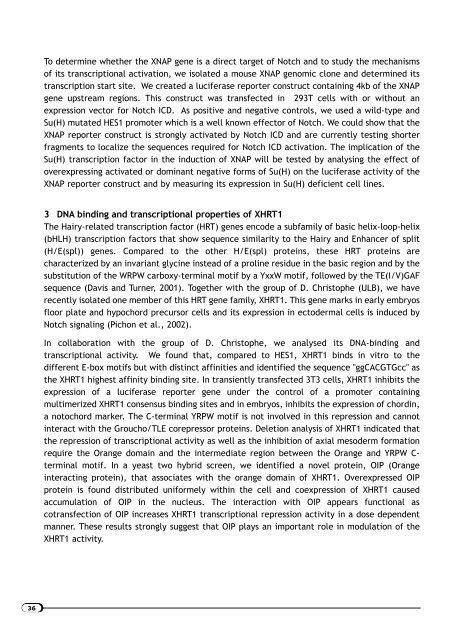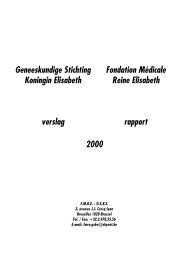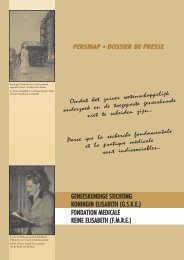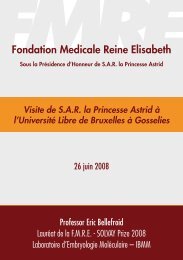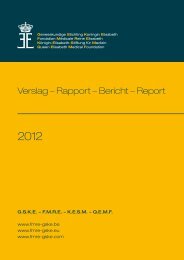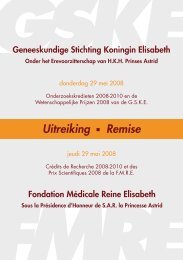Geneeskundige Stichting Koningin Elisabeth verslag - GSKE - FMRE
Geneeskundige Stichting Koningin Elisabeth verslag - GSKE - FMRE
Geneeskundige Stichting Koningin Elisabeth verslag - GSKE - FMRE
You also want an ePaper? Increase the reach of your titles
YUMPU automatically turns print PDFs into web optimized ePapers that Google loves.
36<br />
To determine whether the XNAP gene is a direct target of Notch and to study the mechanisms<br />
of its transcriptional activation, we isolated a mouse XNAP genomic clone and determined its<br />
transcription start site. We created a luciferase reporter construct containing 4kb of the XNAP<br />
gene upstream regions. This construct was transfected in 293T cells with or without an<br />
expression vector for Notch ICD. As positive and negative controls, we used a wild-type and<br />
Su(H) mutated HES1 promoter which is a well known effector of Notch. We could show that the<br />
XNAP reporter construct is strongly activated by Notch ICD and are currently testing shorter<br />
fragments to localize the sequences required for Notch ICD activation. The implication of the<br />
Su(H) transcription factor in the induction of XNAP will be tested by analysing the effect of<br />
overexpressing activated or dominant negative forms of Su(H) on the luciferase activity of the<br />
XNAP reporter construct and by measuring its expression in Su(H) deficient cell lines.<br />
3 DNA binding and transcriptional properties of XHRT1<br />
The Hairy-related transcription factor (HRT) genes encode a subfamily of basic helix-loop-helix<br />
(bHLH) transcription factors that show sequence similarity to the Hairy and Enhancer of split<br />
(H/E(spl)) genes. Compared to the other H/E(spl) proteins, these HRT proteins are<br />
characterized by an invariant glycine instead of a proline residue in the basic region and by the<br />
substitution of the WRPW carboxy-terminal motif by a YxxW motif, followed by the TE(I/V)GAF<br />
sequence (Davis and Turner, 2001). Together with the group of D. Christophe (ULB), we have<br />
recently isolated one member of this HRT gene family, XHRT1. This gene marks in early embryos<br />
floor plate and hypochord precursor cells and its expression in ectodermal cells is induced by<br />
Notch signaling (Pichon et al., 2002).<br />
In collaboration with the group of D. Christophe, we analysed its DNA-binding and<br />
transcriptional activity. We found that, compared to HES1, XHRT1 binds in vitro to the<br />
different E-box motifs but with distinct affinities and identified the sequence "ggCACGTGcc" as<br />
the XHRT1 highest affinity binding site. In transiently transfected 3T3 cells, XHRT1 inhibits the<br />
expression of a luciferase reporter gene under the control of a promoter containing<br />
multimerized XHRT1 consensus binding sites and in embryos, inhibits the expression of chordin,<br />
a notochord marker. The C-terminal YRPW motif is not involved in this repression and cannot<br />
interact with the Groucho/TLE corepressor proteins. Deletion analysis of XHRT1 indicated that<br />
the repression of transcriptional activity as well as the inhibition of axial mesoderm formation<br />
require the Orange domain and the intermediate region between the Orange and YRPW Cterminal<br />
motif. In a yeast two hybrid screen, we identified a novel protein, OIP (Orange<br />
interacting protein), that associates with the orange domain of XHRT1. Overexpressed OIP<br />
protein is found distributed uniformely within the cell and coexpression of XHRT1 caused<br />
accumulation of OIP in the nucleus. The interaction with OIP appears functional as<br />
cotransfection of OIP increases XHRT1 transcriptional repression activity in a dose dependent<br />
manner. These results strongly suggest that OIP plays an important role in modulation of the<br />
XHRT1 activity.


